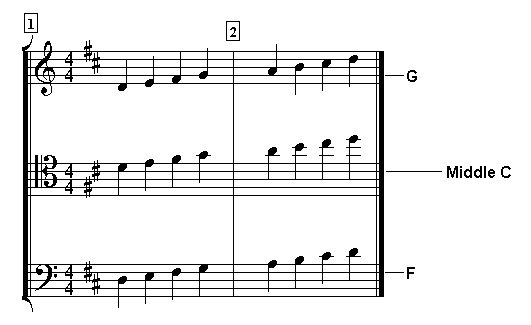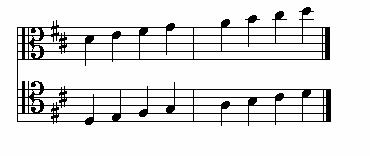Section 5: Understanding Relationships
Understanding the relationships between the clefs is a process that you are already familiar with. It is done by note identifying the relation to Middle C. Look at Figure F and pay close attention to each of the staves. Let us look at the relationships step by step.

Figure F (D Major Scale in Three Clefs)
Here is a brief summary of what we have already covered.
- Treble clef, (G clef), is defined by its position of the G line above Middle C.
- The Bass clef, (F clef), is defined by its position of the F line below Middle C.
- The Treble clef, (C clef), is defined by the position of Middle C, placed on the fourth line of the staff.
Knowing this, and placing the clefs in order as they appear with consideration to Middle C, it would be very wrong to define the Tenor clef by stating that it is, (relationally speaking), "between" the Treble and Bass clefs. Physically this may be true, but you must remember that we do not define clef relationships by their position on the score, but rather by the position of Middle C. Remember the definitions for the different clefs? Every clef is defined by position above or below Middle C. Let us take a closer look at the three clefs and the Middle C relationship between them. If you were to take all three clefs and place them one on top of the other and then locate the position of Middle C, this is what you would see, (See Figure G).

Figure G (The Clef & Middle C)
- The Treble staff is above Middle C.
- The Bass Staff is below Middle C.
- Middle C is on the second line down from the top on the Tenor Staff.
As you can see from Figure G, the Treble clef and Bass clef are positioned absolute in relation to Middle C, but not so with the Tenor clef. It is positioned slightly lower than Middle C. Tenor clef is not exactly "between" the Treble and Bass clefs. It is, rather, slightly above the Bass clef. Why is that?
There is, in fact, a fourth clef that we will briefly mention for the relational purposes. This fourth clef is called the Alto clef, and Middle C is placed on the third line of the staff.

Figure H (D Major Scale in Tenor & Alto Clefs)
Figure H shows how close the Tenor and Alto clefs are to each other. The first thing you will notice is that the symbols for the Tenor clef and Alto clefs are exactly the same. You will also notice that the Tenor clef symbol, (bottom staff), is seated on the second line up from the bottom. This is the F line on the Tenor staff. The Alto clef symbol, (top staff), is seated on the bottom line of the staff, or the D line. Take a look at Figure I.

Figure I (Middle C in Four Clefs)
The figure shows the D Major scale in all four clefs. More importantly it shows the full relation of each staff with consideration to Middle C. Note the position of Middle C on both the Alto and Tenor clefs. On the Alto clef, Middle C is on the 3rd or middle line of the staff and on the Tenor clef is on the 4th.
In relation to Middle C, the Alto clef is a whole-step higher than the Tenor clef. The Alto clef is also called the viola clef. The order of the four staves are Treble, Alto, Tenor, and Bass, both in pitch and in relation to Middle C, and is so written on a score.